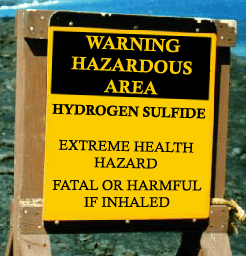
Oil and Gas Well Drilling and Servicing eTool
Home | Site Preparation | Drilling | Well Completion | Servicing | Plug and Abandon Well | General Safety and Health
Site Map | Glossary of Terms | Illustrated Glossary
General Safety and Health H2S Special Precautions

Figure 1. Hydrogen Sulfide warning sign
Hydrogen Sulfide gas is very corrosive and causes metals to become brittle. Therefore, employers need to take special precautions when choosing equipment when they may reasonably expect to encounter H2S. This may include appropriate H2S trimming of equipment in accordance with National Association of Corrosion Engineers (NACE) Standards.
All well-drilling sites should be classified according to areas of potential and/or actual exposure to H2S. The recommendations and employee instruction will vary depending on the type of area. The four hazard levels are:
- No Hazard Condition
- API Condition I - Low Hazard
- API Condition II - Medium Hazard
- API Condition III - High Hazard
Additional Information
- Standards. American Petroleum Institute (API).
- Search for Standards. American National Standards Institute (ANSI).
- Health, Safety & Environmental (HSE) Reference Guide. International Association of Drilling Contractors (IADC).
- ANSI Z390.1 - 2006, Accepted Practices for Hydrogen Sulfide Safety Training Programs. American Society of Safety Engineers (ASSE).
- Hydrogen Sulfide. National Institute for Occupational Safety and Health (NIOSH) Safety and Health Topic.
-
Safety Issues. Association of Energy Services Companies (AESC).
Back to Top
- Use of Anchors and Guywires
- Use of Compressed Gas Cylinders
- Crane Operation
- Proper Electrical Safety (including hot sticks)
- Hot Work
- Fall Protection Systems
- H2S - Hydrogen Sulfide
- Respirator Usage
- Use of wooden, metal and plastic (fiberglass) portable ladders
- Scaffolding
- Vehicle Operation
Any well that will not penetrate a known Hydrogen Sulfide formation would be categorized as a No Hazard Area. Special Hydrogen Sulfide equipment is not required.
Work locations where atmospheric concentrations of H2S are less than 10ppm.
Recommended for Area:
- Hydrogen Sulfide warning sign with green flag warning device present.
- Keep all safety equipment in adequate working order.
- Store the equipment in accessible locations.
Work locations where atmospheric concentrations of H2S are greater than 10ppm and less than 30ppm.
Recommended for Area:
- Legible Hydrogen Sulfide warning sign with yellow flag warning device present.
- Keep a safe distance from dangerous locations if not working to decrease danger.
- Pay attention to audible and visual alarm systems.
- Follow the guidance of the operator representative.
- Keep all safety equipment in adequate working order.
- Store the equipment in accessible locations.
- An oxygen resuscitator.
- A properly calibrated, metered hydrogen sulfide detection instrument.
Work locations where atmospheric concentrations of H2S are greater than 30ppm.
Recommended for Area:
- Post legible Hydrogen Sulfide warning sign with red flag warning device.
- Post signs 500 feet from the location on each road leading to the location, warning of the hydrogen sulfide hazard.
- Check all Hydrogen Sulfide safety equipment to ensure readiness before each tour change.
- Establish a means of communication or instruction for emergency procedures and maintain them on location, along with contact information of persons to be informed in case of emergencies.
- Ensure usability of two exits at each location.
- Do not permit employees on location without hydrogen Sulfide safety training. (Employees may be permitted on location for specific Hydrogen Sulfide training purposes that does not include general rig training.)
- Pay attention to audible and visual alarm systems.
- Store the equipment in accessible locations.
- Two Hydrogen Sulfide detectors should be present (one should be a properly calibrated, metered detection instrument, and the other should be a pump type with detector tubes. The maximum permissible exposure limit (PEL) is 20 ppm. Respiratory protection would be required if periodic testing indicates employee exposures to H2S at concentrations above the PEL. See OSHA Standard Respiratory Protection, [29 CFR 1910.134].
- Oxygen resuscitator.
- Three wind socks and streamers.
- Two NIOSH/MSHA 30-minute, self-contained breathing apparatus for emergency escape from the contaminated area only.
Thank You for Visiting Our Website
You are exiting the Department of Labor's Web server.
The Department of Labor does not endorse, takes no responsibility for, and exercises no control over the linked organization or its views, or contents, nor does it vouch for the accuracy or accessibility of the information contained on the destination server. The Department of Labor also cannot authorize the use of copyrighted materials contained in linked Web sites. Users must request such authorization from the sponsor of the linked Web site. Thank you for visiting our site. Please click the button below to continue.
Close
 Translate
Translate